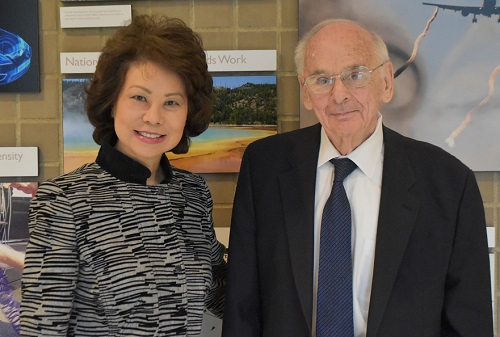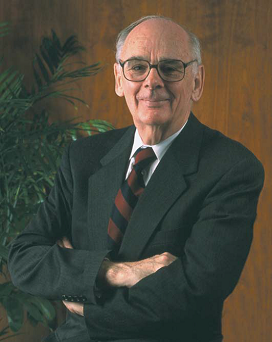Dr. Richard John: Laser-Focused on Global Challenges, Innovation, and the Future of the Nation’s Transportation System
Honoring Over 45 Years of Federal Service
In November, Dr. Richard R. (“Dick”) John, distinguished director of the U.S. Department of Transportation’s (U.S. DOT) Volpe Center from 1989 to 2004 and now director emeritus, will retire from public service following a federal career that spanned five decades.
A charter member of the federal Senior Executive Service, Dr. John became respected here and abroad for being a thought leader on critical issues related to advancing the global transportation system.
Recently, U.S. Secretary of Transportation Elaine L. Chao reminisced about presiding at the official ceremony renaming the U.S. DOT facility in honor of former Secretary of Transportation John A. Volpe in 1991. At the time, she was Deputy Secretary.
“Dr. John’s leadership during his tenure at the Volpe Center has made significant contributions to safety and innovation in all modes of transportation,” said Secretary Chao. “We all wish him the very best as he enters the next exciting chapter of his life after over 45 years of government service. We all thank him for his outstanding service to our country.”

U.S. Secretary of Transportation Elaine L. Chao and Volpe Center Director Emeritus Dr. Richard R. John, together at the U.S. DOT Volpe Center earlier this year. (Volpe photo)
“In his years leading Volpe as director and director emeritus, Dr. John has focused on the Center’s mission to anticipate and create awareness of national, state, local, and international transportation issues,” said Anne Aylward, current Volpe Center director. “He is renowned for walking the halls at Volpe, constantly sharing ideas with staff from our newest graduates to our most seasoned veterans.”
“Dr. John embodies the soul of Volpe: pioneering, thinking forward, and innovating, all of which is focused on serving the public good around transportation,” remarked Dr. Stephen Popkin, the Volpe Center’s deputy director for Research and Technology. “His energy, intellect, and passion on serving our nation and partners is an inspiration for all those who know and work with him. Dr. John has been a personal role model for me to evaluate my contributions to Volpe and the Department. He has always been there to provide me both wise counsel and the fortitude to carry through, even in challenging times.”
Dr. John completed his training in physics and aeronautical engineering from Princeton University at a defining moment in American history. Within a few months of receiving his doctorate in 1957, history changed with the Soviet Union’s successful launch of Sputnik. This unexpected event marked the dawn of the space age and America’s race with the Soviets.
With U.S. science and engineering in a state of major upheaval, Dr. John rolled up his sleeves and did what he does best—turned his attention to the complex national challenges at hand and kept an eye on the horizon.
Early Contributor to the Nation’s Space Program
In step with President John F. Kennedy’s challenge to land a man on the moon and return him safely to Earth within a decade, Dr. John pioneered a series of nationally recognized development programs in space propulsion, electro-optical systems, and re-entry vehicle development while serving as director of the aerophysics laboratory at the Avco Corporation in Massachusetts. It was there he helped the nation solve a major technological challenge: the development of heat shields that prevented manned and unmanned re-entry vehicles from burning up as they entered the earth’s atmosphere.
Dr. John first began walking the corridors of the newly established Transportation System Center (TSC) in Cambridge, Massachusetts, in January 1971, shortly after it morphed from being NASA’s Electronics Research Center (ERC) to a U.S. DOT systems center and think tank. At the time, budget decisions were made at NASA that led to the shutdown of the ERC. His arrival, soon after U.S. DOT was established, was amid heightened concern about the state of the nation’s transportation system. Dr. John was instrumental in redirecting the former ERC toward transportation and led development and implementation of a world-class multimodal transportation engineering capability.
Leader in Automotive Industry Analysis
When the energy crisis first gripped the nation, Dr. John’s teams were deep at work on electrical power systems and energy efficiency. When the 1973 international oil embargo led to unprecedented inflation and widespread panic at the pump, the country turned attention to domestic energy independence.
Dr. John emerged as a respected leader among government and automobile industry executives, known for successfully bringing technical consensus to the forefront in the resolution of safety, energy, and trade issues. Working closely with the Office of the U.S. Secretary of Transportation, he led the Center’s support to the National Highway Traffic Safety Administration and the first research establishing the practicability of doubling motor vehicle fuel economy.
Under Dr. John’s leadership, the Center became recognized as a world leader in automotive industry analysis. When the government stepped in to bailout Chrysler in 1979, Dr. John led assessments of the long-term viability of the corporation. He received Departmental honors from three U.S. transportation secretaries—William Coleman, Neil Goldschmidt, and Drew Lewis—for his outstanding contributions to the Federal Task Force on Motor Vehicle Goals Beyond 1980 and his leadership role in developing the government’s response to the problems of the U.S. auto industry.
“In the 1990s, interest in fuel economy had receded somewhat as fuel prices remained low for an extended period. Dr. John was instrumental in maintaining U.S. DOT’s role in related technology development initiatives, and in engaging the Department in related policy consideration surrounding greenhouse gas emissions,” remarked Kevin Green, chief of the Volpe Center’s Corporate Average Fuel Economy (CAFE) Office. “Along with the Center’s long-standing institutional role vis-à-vis CAFE—a role Dr. John himself had led—that continued engagement provided a foundation for the Department’s resumed leadership, starting in 2001, in the establishment of CAFE standards.”
Innovator and Thought Leader
A vocal and sustained proponent of analyzing future transportation alternatives and issues and stimulating courses of action aligned with Secretarial priorities, Dr. John initiated a small, effective strategic planning activity at Volpe. The team informed a series of key national planning documents, conducted major outreach activities, and supported high-profile White House and Secretarial strategic planning activities. Dr. John was a driving force behind the creation of the White House National Science and Technology Council (NSTC) transportation committee and supported former Deputy Secretary Mortimer Downey to ensure transportation was fully represented.
“The Department’s engagement of current high-profile issues often occurs as a matter of course," said Green, who was also a former member of the strategic planning team. "As a champion of active and applied strategic thinking, Dr. John constantly pushed to engage the Department in issues that, though not ‘front and center,’ were important and likely to become recognized as such."
For over a decade, Dr. John guided the Volpe strategy team while it served as key support to the NSTC transportation initiative. He steered a series of successful planning documents including the first-ever U.S. Transportation Science and Technology Strategy and contributed to the development of multiple U.S. DOT strategic plans and policies including U.S. Transportation Secretary Samuel Skinner’s Moving America, Secretary Rodney Slater’s Transportation Policy Architecture and Changing Face of Transportation, and the Department’s first-ever congressionally mandated transportation research and development strategic plans.
Awards and Recognition
Notably, Dr. John has been recognized at the highest levels, with two Distinguished Presidential Rank Awards from Presidents Ronald Reagan and William Clinton and one Meritorious Rank Award from President George H.W. Bush, for his sustained and extraordinary accomplishments and for representing the very best in public service, innovation, and commitment to accomplishing the mission of the federal government.
In 2011, Dr. John received the annual American Institute for Aeronautics and Astronautics (AIAA) prestigious Public Service Award for excellence in national leadership and life-long contributions to the nation’s aviation and aerospace enterprise. He joined a distinguished group of past AIAA public service award winners including former U.S. Transportation Secretary Norman Mineta, former U.S. Senator Barry Goldwater, and Walter Cronkite.
During Dr. John’s tenure as office director and later director, the Volpe Center became recognized as both a unique, world-class multidisciplinary capability in transportation systems and a prototype fee-for-service federal center. Under his stewardship, the Volpe Center successfully obligated over 3.5 billion dollars in support to U.S. DOT, the U.S. Department of Defense, and a number of other major organizations with critical transportation-related missions. Dr. John continues to be known for his intellect, integrity, and transportation expertise.
Perhaps Dr. John’s greatest legacy, however, is the Volpe Center itself—a world class federal center for advancing transportation innovation—and his ongoing efforts to mentor the next generation.
By Ellen Bell, director of Strategic Initiatives for Research and Innovation, U.S. DOT Volpe Center. Bell served as senior advisor to Dr. John during his tenure as director and as a member of the strategic planning team.

